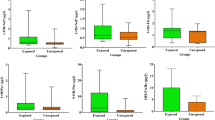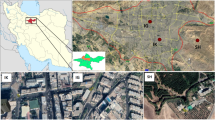Abstract
This study aims to determine the atmospheric concentrations of particulate matter 2.5 (PM2.5)-bounded polycyclic aromatic hydrocarbons (PAHs) and their association with their urinary metabolites in children and adolescents. This study was conducted from October 2014 to March 2016 in Isfahan, Iran. We measured 16 species of PAHs bounded to PM2.5 by gas chromatography mass spectrometry (GC/MS) from 7 parts of the city. Moreover, PAH urinary metabolites were measured in 186 children and adolescents, randomly selected from households. Urinary metabolites consisted of 1-hydroxy naphthalene (1-naphthol), 2-hydroxy naphthalene (2-naphthol), 9-hydroxy phenanthrene (9-phenanthrol), and 1-hydroxy pyrene using GC/MS. Considering the short half-lives of PAHs, we measured the metabolites twice with 4 to 6 months of time interval. We found that the ambient concentrations of PAHs were significantly associated with their urinary metabolites. 1-hydroxy naphthalene and 2-hydroxy naphthalene concentrations showed an increase of 1.049 (95% CI: 1.030, 1.069) and 1.047 (95% CI: 1.025, 1.066) for each unit increase (1 ng/m3) in ambient naphthalene. Similarly, 1-hydroxy pyrene showed an increase of 1.009 (95% CI: 1.006–1.011) for each unit increase (1 ng/m3) in ambient pyrene concentration after adjustment for body mass index, physical activity level, urinary creatinine, age, and sex. The association of urinary 9-hydroxyphenanthrene and ambient phenantherene was significant in the crude model; however after adjustment for the abovementioned covariates, it was no more significant. We found significant correlations between exposure to ambient PM2.5-bounded PAHs and their urinary excretion. Considering the adverse health effects of PAHs in the pediatric age group, biomonitoring of PAHs should be underscored; preventive measures need to be intensified.

Similar content being viewed by others
References
Al-Daghri NM, Alokail MS, Abd-Alrahman SH, Draz HM, Yakout SM, Clerici M (2013) Polycyclic aromatic hydrocarbon exposure and pediatric asthma in children: a case–control study. Environ Health 12(1):1
Alghamdi MA, Alam MS, Stark C, Mohammed N, Harrison RM, Shamy M, Khoder MI, Shabbaj II, Goen T (2015) Urinary metabolites of polycyclic aromatic hydrocarbons in Saudi Arabian schoolchildren in relation to sources of exposure. Environ Res 140:495–501
Allan LL, Sherr DH (2010) Disruption of human plasma cell differentiation by an environmental polycyclic aromatic hydrocarbon: a mechanistic immunotoxicological study. Environ Health 9:15
Alshaarawy O, Elbaz HA, Andrew ME (2016) The association of urinary polycyclic aromatic hydrocarbon biomarkers and cardiovascular disease in the US population. Environ Int 89-90:174–178
Aquilina NJ, Delgado-Saborit JM, Meddings C, Baker S, Harrison RM, Jacob P III, Wilson M, Yu L, Duan M, Benowitz NL (2010) Environmental and biological monitoring of exposures to PAHs and ETS in the general population. Environ Int 36:763–771
ATSDR U (2005) Toxicological profile for naphthalene, 1-methylnaphthalene, and 2-methylnaphthalene. US Department of Health and Human Services, Agency for Toxic Substances and Disease Registry. accessed 16 April 2017
Campo L, Buratti M, Fustinoni S, Cirla PE, Martinotti I, Longhi O, Cavallo D, Foa V (2006) Evaluation of exposure to PAHs in asphalt workers by environmental and biological monitoring. Ann N Y Acad Sci 1076:405–420
Cavanagh JA, Brown L, Trought K, Kingham S, Epton MJ (2007) Elevated concentrations of 1-hydroxypyrene in schoolchildren during winter in Christchurch, New Zealand. Sci Total Environ 374:51–59
CDC (2017) https://www.cdc.gov/physicalactivity/basics/children. Last accessed Jan 12
Chen YT, Huang YK, Luvsan ME, Gombojav E, Ochir C, Bulgan J, Chan CC (2015) The influence of season and living environment on children’s urinary 1-hydroxypyrene levels in Ulaanbaatar, Mongolia. Environ Res 137:170–175
Chen Y-C, Chiang H-C, Hsu C-Y, Yang T-T, Lin T-Y, Chen M-J, Chen N-T, Wu Y-S (2016) Ambient PM2.5-bound polycyclic aromatic hydrocarbons (PAHs) in Changhua County, central Taiwan: seasonal variation, source apportionment and cancer risk assessment. Environ Pollut 218:372–382
Fan R, Wang D, Mao C, Ou S, Lian Z, Huang S, Lin Q, Ding R, She J (2012) Preliminary study of children’s exposure to PAHs and its association with 8-hydroxy-2′-deoxyguanosine in Guangzhou, China. Environ Int 42:53–58
Fiala Z, Vyskocil A, Krajak V, Viau C, Ettlerova E, Bukac J, Fialova D, Emminger S (2001) Environmental exposure of small children to polycyclic aromatic hydrocarbons. Int Arch Occup Environ Health 74:411–420
Gunier RB, Reynolds P, Hurley SE, Yerabati S, Hertz A, Strickland P, Horn-Ross PL (2006) Estimating exposure to polycyclic aromatic hydrocarbons: a comparison of survey, biological monitoring, and geographic information system-based methods. Cancer Epidemiol Biomark Prev 15:1376–1381
Han X, Zhou N, Cui Z, Ma M, Li L, Cai M, Li Y, Lin H, Li Y, Ao L, Liu J, Cao J (2011) Association between urinary polycyclic aromatic hydrocarbon metabolites and sperm DNA damage: a population study in Chongqing, China. Environ Health Perspect 119:652–657
Hansen ÅM, Mathiesen L, Pedersen M, Knudsen LE (2008) Urinary 1-hydroxypyrene (1-HP) in environmental and occupational studies—a review. Int J Hyg Environ Health 211(5):471–503
Heudorf U, Angerer J (2001) Internal exposure to PAHs of children and adults living in homes with parquet flooring containing high levels of PAHs in the parquet glue. Int Arch Occup Environ Health 74:91–101
Ifegwu OC, Anyakora C (2015) Polycyclic aromatic hydrocarbons: part I. Exposure. Adv Clin Chem 72:277–304
Ifegwu OC, Anyakora C (2016) Polycyclic aromatic hydrocarbons: part II, urine markers. Adv Clin Chem 75:159–183
Jacob J, Seidel A (2002) Biomonitoring of polycyclic aromatic hydrocarbons in human urine. J Chromatogr B 778:31–47
Jamhari AA, Sahani M, Latif MT, Chan KM, Tan HS, Khan MF, Mohd Tahir N (2014) Concentration and source identification of polycyclic aromatic hydrocarbons (PAHs) in PM10 of urban, industrial and semi-urban areas in Malaysia. Atmos Environ 86:16–27
Jia J, Bi C, Guo X, Wang X, Zhou X, Chen Z (2017) Characteristics, identification, and potential risk of polycyclicaromatic hydrocarbons in road dusts and agricultural soils from industrial sites in Shanghai, China. Environ Sci Pollut Res Int 24(1):605–615
Jung KH, Hsu Sh-I, Yan B, Moors K, Chillurd SN, Ross J et al (2012) Childhood exposure to fine particulate matter and black carbon and the development of new wheeze between ages 5 and 7 in an urban prospective cohort. Environ Int 45:44–50
Jung KH, Liu B, Lovinsky-Desir S, Yan B, Camann D, Sjodin A, Li Z, Perera F, Kinney P, Chillrud S, Miller RL (2014) Time trends of polycyclic aromatic hydrocarbon exposure in New York City from 2001 to 2012: assessed by repeat air and urine samples. Environ Res 131:95–103
Kamal A, Cincinelli A, Martellini T, Malik RN (2016) Biomarkers of PAH exposure and hematologic effects in subjects exposed to combustion emission during residential (and professional) cooking practices in Pakistan. Environ Sci Pollut Res Int 23:1284–1299
Korsh J, Shen A, Aliano K, Davenport T (2015) Polycyclic aromatic hydrocarbons and breast cancer: a review of the literature. Breast Care (Basel) 10:316–318
Lee MS, Eum KD, Zoh KD, Kim TS, Pak YS, Paek D (2007) 1-hydroxypyrene as a biomarker of PAH exposure among subjects living in two separate regions from a steel mill. Int Arch Occup Environ Health 80:671–678
Leroyer A, Jeandel F, Maitre A, Howsam M, Deplanque D, Mazzuca M, Nisse C (2010) 1-Hydroxypyrene and 3-hydroxybenzo[a]pyrene as biomarkers of exposure to PAH in various environmental exposure situations. Sci Total Environ 408:1166–1173
Li Z, Sandau CD, Romanoff LC, Caudill SP, Sjodin A, Needham LL, Patterson DG Jr (2008) Concentration and profile of 22 urinary polycyclic aromatic hydrocarbon metabolites in the US population. Environ Res 107:320–331
Li Z, Mulholland JA, Romanoff LC, Pittman EN, Trinidad DA, Lewin MD, Sjödin A (2010) Assessment of nonoccupational exposure to polycyclic aromatic hydrocarbons through personal air sampling and urinary biomonitoring. J Environ Monit 12(5):1110–1118
Li Z, Romanoff L, Bartell S, Pittman EN, Trinidad DA, McClean M, Webster TF, Sjödin A (2012) Excretion profiles and half-lives of ten urinary polycyclic aromatic hydrocarbon metabolites after dietary exposure. Chem Res Toxicol 16;25(7):1452–1461
Liaud C, Millet M, Le Calve S (2015) An analytical method coupling accelerated solvent extraction and HPLC-fluorescence for the quantification of particle-bound PAHs in indoor air sampled with a 3-stages cascade impactor. Talanta 131:386–394
Liu B, Xue Z, Zhu X, Jia C (2017) Long-term trends (1990-2014), health risks, and sources of atmospheric polycyclic aromatic hydrocarbons (PAHs) in the U.S. Environ Pollut 220(Pt B):1171–1179
Liu H, Xu C, Jiang ZY, Gu A (2016) Association of polycyclic aromatic hydrocarbons and asthma among children 6–19 years: NHANES 2001–2008 and NHANES 2011–2012. Respir Med 110:20–27
Ma Y, Harrad S (2015) Spatiotemporal analysis and human exposure assessment on polycyclic aromatic hydrocarbons in indoor air, settled house dust, and diet: a review. Environ Int 84:7–16
Martinez-Salinas RI, Perez-Maldonado IN, Batres-Esquivel LE, Flores-Ramirez R, Diaz-Barriga F (2011) Assessment of DDT, DDE, and 1-hydroxypyrene levels in blood and urine samples in children from Chiapas Mexico. Environ Sci Pollut Res Int 19:2658–2666
Montgomery AA, Graham A, Evans PH, Fahey T (2002) Inter-rater agreement in the scoring of abstracts submitted to a primary care research conference. BMC Health Serv Res 2:8
Morgan MK, Jones PA, Sobus JR, Chuang JC, Wilson NK (2015) Using urinary biomarkers to evaluate polycyclic aromatic hydrocarbon exposure in 126 preschool children in Ohio. Int J Environ Health Res 25:628–639
Oliveira M, Slezakova K, Delerue-Matos C, Do Carmo Pereira M, Morais S (2017) Assessment of exposure to polycyclic aromatic hydrocarbons in preschool children: levels and impact of preschool indoor air on excretion of main urinary monohydroxyl metabolites. J Hazard Mater 322(Part B):357–369
Perera FP (2008) Children are likely to suffer most from our fossil fuel addiction. Environ Health Perspect 116:987–990
Ranjbar M, Rotondi MA, Ardern CI, Kuk JL (2015) Urinary biomarkers of polycyclic aromatic hydrocarbons are associated with cardiometabolic health risk. PLoS One 10:e0137536
Ravindra K, Sokhi R, Van Grieken R (2008) Atmospheric polycyclic aromatic hydrocarbons: source attribution, emission factors and regulation. Atmos Environ 42:2895–2921
Romanoff LC, Li Z, Young KJ, Blakely NC III, Patterson DGJR, Sandau CD (2006) Automated solid-phase extraction method for measuring urinary polycyclic aromatic hydrocarbon metabolites in human biomonitoring using isotope-dilution gas chromatography high-resolution mass spectrometry. J Chromatogr B Analyt Technol Biomed Life Sci 835:47–54
Rossbach B, Preuss R, Letzel S, Drexler H, Angerer J (2007) Biological monitoring of occupational exposure to polycyclic aromatic hydrocarbons (PAH) by determination of monohydroxylated metabolites of phenanthrene and pyrene in urine. Int Arch Occup Environ Health 81:221–229
Rossella F, Campo L, Pavanello S, Kapka L, Siwinska E, Fustinoni S (2009) Urinary polycyclic aromatic hydrocarbons and monohydroxy metabolites as biomarkers of exposure in coke oven workers. Occup Environ Med 66:509–516
Sarigiannis D, Karakitsios SP, Zikopoulos D, Nikolaki S, Kermenidou M (2015) Lung cancer risk from PAHs emitted from biomass combustion. Environ Res 137:147–156
Scherer G, Frank S, Riedel K, Meger-Kossien I, Renner T (2000) Biomonitoring of exposure to polycyclic aromatic hydrocarbons of nonoccupationally exposed persons. Cancer Epidemiol Biomark Prev 9(4):373–380
Scinicariello F, Buser MC (2014) Urinary polycyclic aromatic hydrocarbons and childhood obesity: NHANES (2001–2006). Environ Health Perspect 122:299–303
Thai PK, Heffernan AL, Toms LM, Li Z, Calafat AM, Hobson P, Broomhall S, Mueller JF (2016) Monitoring exposure to polycyclic aromatic hydrocarbons in an Australian population using pooled urine samples. Environ Int 88:30–35
Tuntawiroon J, Mahidol C, Navasumrit P, Autrup H, Ruchirawat M (2007) Increased health risk in Bangkok children exposed to polycyclic aromatic hydrocarbons from traffic-related sources. Carcinogenesis 28:816–822
Watson JG, Chow JC, Chen LWA, Kohl SD, Casuccio GS, Lersch TL, Langston R (2012) Elemental and morphological analyses of filter tape deposits from a beta attenuation monitor. Atmos Res 106:181–189
White AJ, Bradshaw PT, Herring AH, Teitelbaum SL, Beyea J, Stellman SD, Steck SE, Mordukhovich I, Eng SM, Engel LS, Conway K, Hatch M, Neugut AI, Santella RM, Gammon MD (2016) Exposure to multiple sources of polycyclic aromatic hydrocarbons and breast cancer incidence. Environ Int 89-90:185–192
Zhang Y, Dong S, Wang H, Tao S, Kiyama R (2016) Biological impact of environmental polycyclic aromatic hydrocarbons (ePAHs) as endocrine disruptors. Environ Pollut 213:809–824
Author information
Authors and Affiliations
Corresponding author
Ethics declarations
The Research Council and Ethics Committee of Isfahan University of Medical Sciences, Isfahan, Iran, approved the study (Project No.193042). Written informed consent was obtained from parents and oral assent from participants prior to enrolment in the study.
Additional information
Responsible editor: Philippe Garrigues
Rights and permissions
About this article
Cite this article
Poursafa, P., Amin, M.M., Hajizadeh, Y. et al. Association of atmospheric concentrations of polycyclic aromatic hydrocarbons with their urinary metabolites in children and adolescents. Environ Sci Pollut Res 24, 17136–17144 (2017). https://doi.org/10.1007/s11356-017-9315-8
Received:
Accepted:
Published:
Issue Date:
DOI: https://doi.org/10.1007/s11356-017-9315-8




